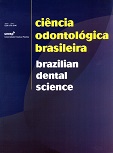Análise da rugosidade superficial de diferentes materiais restauradores estéticos após polimento com discos ou pastas abrasivas
DOI:
https://doi.org/10.14295/bds.2009.v12i4.642Resumo
O objetivo deste estudo foi avaliar a rugosidade superficial de diferentes materiais restauradores estéticos após polimento com discos ou pastas abrasivas. Foram confeccionados 20 espécimes para cada tipo de material restaurador utilizando uma matriz pré-fabricada, resultando nos grupos: PE (Palfique Estelite), DY (Dyract Extra), A1 (A110), QF (QuiXfil) e GR (Grandio). A rugosidade superficial dos espécimes foi padronizada utilizando discos Sof-Lex de granulação alta. Cada grupo foi dividido em dois subgrupos, de acordo com a técnica de polimento. No subgrupo S, foram empregados os discos de lixa Sof-Lex de granulação média, fina e ultrafina. No subgrupo D, foram empregados discos de feltro Diamond Flex associados às pastas de polimento Poli I, Poli II e FotoGloss. A rugosidade superficial foi mensurada com um rugosímetro Penthometer S8P. Os resultados foram analisados pelos testes estatísticos de ANOVA e Tukey (5%), obtendo-se p = 0,00. Os valores de média (± desvio-padrão) medidos em Ra (μm) para cada Grupo/Subgrupo foram: GR/D – 1,72 (± 0,11)a; A1/S – 1,62 (± 0,43)a; QF/D – 1,58 (± 0,09)a; QF/S – 1,01 (± 0,70)b; DY/D – 0,96 (±0,09)b; GR/S – 0,90 (± 0,79)b; DY/S – 0,82 (± 0,29)b; PE/D – 0,72 (± 0,15)b; A1/D – 0,58 (± 0,21)b; PE/S – 0,53 (± 0,15)b. As médias acompanhadas das mesmas letras não apresentam diferenças significantes. Concluiu-se que para as resinas compostas PE, GR e QF, os discos Sof-Lex proporcionaram menor rugosidade. Para a resina composta A110, as pastas abrasivas proporcionaram menor rugosidade e para o compômero DY não houve diferença significante entre os métodos de polimento.
Downloads
Downloads
Publicado
Como Citar
Edição
Seção
Licença
TRANSFERÊNCIA DE DIREITOS AUTORAIS E DECLARAÇÃO DE RESPONSABILIDADE
Toda a propriedade de direitos autorais do artigo "____________________________________________________________________" é transferido do autor(es) para a CIÊNCIA ODONTOLÓGICA BRASILEIRA, no caso do trabalho ser publicado. O artigo não foi publicado em outro lugar e não foi submetido simultaneamente para publicação em outra revista.
Vimos por meio deste, atestar que trabalho é original e não apresenta dados manipulados, fraude ou plágio. Fizemos contribuição científica significativa para o estudo e estamos cientes dos dados apresentados e de acordo com a versão final do artigo. Assumimos total responsabilidade pelos aspectos éticos do estudo.
Este texto deve ser impresso e assinado por todos os autores. A versão digitalizada deverá ser apresentada como arquivo suplementar durante o processo de submissão.




























